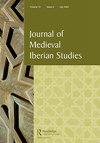米罗,苏维国王(公元583年),以及西班牙西北部的教会身份(11 - 12世纪)
IF 0.4
2区 历史学
0 MEDIEVAL & RENAISSANCE STUDIES
引用次数: 0
摘要
摘要本文试图揭示历史书写过程和宗教历史重塑的各个方面,这些方面成为中世纪伊比利亚一些最重要的教会机构合法化的关键战略要素。重点关注两本书,《孔波斯特拉历史》和《爱尔兰编年史》,这两本书都产于圣地亚哥-德孔波斯特拉教区,每本书都是捍卫这位强大的加利西亚人的权利和权威的基础,我们分析了他们对苏维国王米罗(570–583年在位)的刻画,他被认为是伊斯帕尼亚西北部的教会组织。这两本书都将这位国王描述为加利西亚政治和宗教身份的核心人物。中世纪孔波斯特拉对米罗历史的改写被证明是该教区与其他伊比利亚主教(即布拉加、托莱多、蒙多和卢戈)之间争端的关键因素。本文章由计算机程序翻译,如有差异,请以英文原文为准。
Miro, King of the Suevi (d. 583), and ecclesiastical identities in northwestern Hispania (eleventh-twelfth centuries)
ABSTRACT This paper seeks to reveal aspects of the process of the writing of history and the reinvention of the religious past which became crucial strategic elements in the legitimisation of some of the most important ecclesiastical institutions of medieval Iberia. Focusing on two texts, the Historia Compostellana and the Chronicon Iriense, both produced in the diocese of Santiago de Compostela, and each fundamental in defending the rights and authority of this powerful Galician see, we analyse their portrayal of Miro, king of the Suevi (r. 570–583), to whom is attributed the ecclesiastical organisation of northwestern Hispania. Both texts present this king as a central figure of Galician political and religious identity. The rewriting in medieval Compostela of Miro’s history is shown to be a key element in the disputes between that diocese and other Iberian episcopates, namely Braga, Toledo, Mondoñedo and Lugo.
求助全文
通过发布文献求助,成功后即可免费获取论文全文。
去求助
来源期刊

Journal of Medieval Iberian Studies
MEDIEVAL & RENAISSANCE STUDIES-
CiteScore
1.20
自引率
20.00%
发文量
24
 求助内容:
求助内容: 应助结果提醒方式:
应助结果提醒方式:


